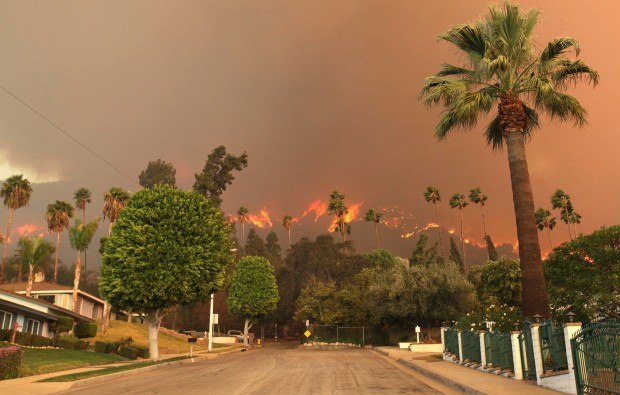Firefighters scoured charred hillsides north of San Diego on Saturday to guard against a resurgence of flames that ripped through the region, while the last of tens of thousands of evacuees prepared to return home. For those battling a series of blazes for days, the relief was mixed with a sense of dread that drought-sapped vegetation, high temperatures and low humidity portend a long fire season ahead.
The California Department of Forestry and Fire Protection has responded to more than 1,500 fires this year, compared with about 800 during an average year.
“Normally, I don’t even put wildfire gear in my vehicle until the end of April. This year I never took it out,” said Kirk Kushen, battalion chief of the Kern County Fire Department said at a base camp in Escondido. “We never really completed the 2013 fire season. It’s been a continuation.”
At least 10 fires spanning 39 square miles have chewed a destructive path through San Diego County since Tuesday, destroying 11 houses, an 18-unit apartment complex and two businesses. A badly burned body was found in a transient camp, and one firefighter suffered heat exhaustion.
The first blaze was caused by a spark from construction equipment, according to state officials, but it could take months to get to the bottom of the most damaging fires. Alberto Serrato, 57, pleaded not guilty Friday to an arson charge in connection with one of the smaller fires, but authorities say they don’t believe he started it, just added brush to it.
Ocean breezes and lower temperatures Saturday aided firefighters, who focused on a 1,000-acre blaze on the Camp Pendleton Marine base and a 4-square-mile blaze that started in the suburb of San Marcos.
Firefighters doused remaining hotspots with hoses and water-filled backpacks, sawed large logs and raked soil with shovels and other hand tools to ensure the ground was moist enough to prevent fires from returning.
Kushen, who was working his 10th straight day and was nearly 27 hours into his shift as his team prepared to go rest at a hotel, saw between 15 and 20 destroyed houses or other structures while combing the hills in and around San Marcos for smoke and smoldering brush.
San Marcos, a suburb of 85,000 people where strip malls and new housing tracts mix with older homes, slowly returned to normal as more roadblocks were removed.
“It’s such a wonderful blessing to be back,” Jamie Williams said as he unloaded three bags of clothing from his car that he took when ordered to evacuate Wednesday night. “It was almost a teary-eyed kind of thing.”
Many evacuations have been lifted, including some on Saturday, but it was unclear when all would be allowed to return to their homes, said Kendal Bortisser, a spokesman for the California Department of Forestry and Fire Protection.
A strike team from Yolo County in Northern California walked hillsides to ensure that nothing within 100 feet of homes could ignite, a final step before allowing residents to return.
“This is a last effort to make sure everything is nice and cool,” said Capt. Cess Mercado of the University of California, Davis, Fire Department who typically doesn’t come to Southern California to assist with firefighting until late August.
The tinder-box conditions have put firefighters on alert throughout California. The state firefighting agency went to peak staffing in the first week of April, instead of its usual start in mid-May.
Battalion Chief Kevin Taylor of the Paso Robles Fire Department in central California usually doesn’t leave home until late July to assist other agencies during the fire season. He was dispatched to the Los Angeles area in January and led a crew that began work near San Diego on Thursday.
“There hasn’t been a break,” said Taylor, as he ate lunch on a shaded tree while on orders to be ready to move on three minutes’ notice. “It’s almost a 12-month fire season.”





















 Underwriter, Actuary Fears of AI Drop; Work Needed on Collaboration
Underwriter, Actuary Fears of AI Drop; Work Needed on Collaboration  Surge of Supercharged Hurricanes Prompt Call for Cat 6 Classification
Surge of Supercharged Hurricanes Prompt Call for Cat 6 Classification  Five AI Trends Reshaping Insurance in 2026
Five AI Trends Reshaping Insurance in 2026  Breaking: Andersen to Replace Zaffino as CEO of AIG on June 1
Breaking: Andersen to Replace Zaffino as CEO of AIG on June 1 





